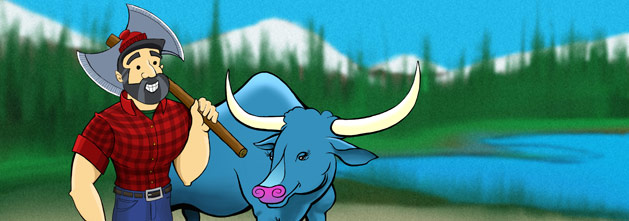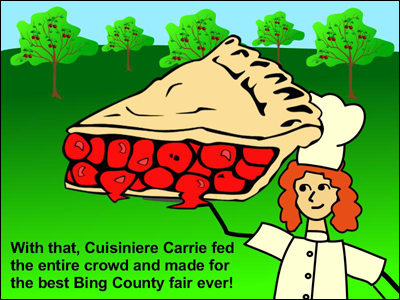
After exploring local history and discussing the characteristics and traits of tall tales and legends, students write their own tales, then transform their tale into a script and create an illustrated or animated version.

Legends and tall tales are stories filled with unbelievable events or exaggerations that explain a person’s character or how something came to be. In this project, you will write and produce your own animated tall tale about a historical figure or location.
Tall tales are filled with larger-than-life characters and places. Begin by sharing some familiar tall tales, such as John Henry, Johnny Appleseed, and Pecos Bill with your students. Your librarian or media specialist is a great resource for locating stories students at your level will love.
Share the historical, factual biographies of some of the characters in the tall tales you are reading. What differences are there between the historical information and the tall tale? Work together to compare the stories and record your findings on a Venn diagram. Make a class list of characteristics that make up a tall tale, such as:
Reflect on what you already know about the history of your area and brainstorm a list of people and places in your region that have these qualities. Which ones might serve as the focal point of a local history tall tale? Why? What makes this person or place a candidate for a tall tale? What elements could be exaggerated to help build this into a legend or tall tale?
Work with your students to create a list of possible topics. You may also want to create a list ahead of time to get students started brainstorming.
Allow students to form teams of 3-5 around a topic that interests them. Have the teams begin with a research session to see what they can learn about the factual history of their person or place.
After completing a first round of research, have them use a cluster-style diagram to write down facts and adjectives that describe this person or place. Student teams should then turn their initial cluster diagram into a larger web showing which characteristics, events, and actions they want to use in their story and explain how they might do so.
Discuss the structure of an effective tall tale with your students. The beginning of the story needs to draw interest and set the theme. The rest of the story needs to support the theme in a logical order and must include carefully exaggerated points to qualify it as a tall tale or legend. The closing should wrap up the story and share why this topic is important to the history of your state.
Before they begin writing, ask each team to clearly define:
The members of each team can work together to write the story or divide it into beginning, middle, and end to work individually before combining their ideas. Creativity will be key in this writing experience, requiring students to choose which facts to exploit and exaggerate for the purpose of the tale. Have each team submit a rough draft for your review, or have teams swap their stories for peer review.
When edits have been made and a final draft of the story is complete, have students create a visual storyboard that divides the story into scenes. The storyboard should contain information about what will be said or read during each scene as well as what illustrations or animations will support the story at that time. Teams will also need to decide if additional dialogue should be written or if the story needs to be adjusted for more effective communication as a video or animation.
Export the finished student work as movies for the Web or for podcast playback.
Present each team’s illustrated/animated tall tale to the rest of the class or at a school assembly. Be sure to discuss the audience’s favorite characters or scenes. What was memorable? What did they like best? Use of language? Humor? Hyperbole?
Create a page on your website to host the student tales as a collection and curate their work. Reach out to your local history society and your local library to join you for the presentations or even to host student work on-site using a kiosk or event.

Begin by evaluating your initial class discussion about tall tales and the characters and events you are learning about. Do they understand what makes a tall tale unique? Can they distinguish between fact and fiction? Their ability to apply this knowledge to identify people and places from history that might qualify for a tall tale will also help to indicate their understanding.
You can use the teams’ cluster and web diagrams, rough draft, final written story, storyboard, and finished movie as both checkpoints and performances to assess. You can assess writing for creativity, organization, and voice, and judge the final video for organization, effective visual communication, and voice.
If students work together to write the story, evaluate the notes and drafts from individual contributors to get a clearer picture of the effort and work of each student. Students should include documentation of resources and notes with their written story. A peer assessment from each team member as well as a self-assessment not only helps you clarify work, it requires students to analyze their performance and determine what actions are necessary for success.
Be sure to evaluate the project process for skills such as teamwork, time management, problem solving, and collaboration.
Perry, Phyllis. Ten Tall Tales. ISBN: 1579500692
West, Tracy. Teaching Tall Tales, Grades 3-5. ISBN: 0590365118
Tall Tales at American Folklore
Writing Standards
Key Ideas and Details
RL.3.2. Recount stories, including fables, folktales, and myths from diverse cultures; determine the central message, lesson, or moral and explain how it is conveyed through key details in the text.
RL.4.1. Refer to details and examples in a text when explaining what th e text says explicitly and when drawing inferences from the text.
W.4.4. Produce clear and coherent writing in which the development and organization are appropriate to task, purpose, and audience. (Grade-specific expectations for writing types are defined in standards 1-3 above.)
RL.5.7. Analyze how visual and multimedia elements contribute to the meaning, tone, or beauty of a text
I. Culture
Social studies programs should include experiences that provide for the study of culture and cultural diversity, so that the learner can compare and contrast different stories or accounts about past events, people, places, or situations, identifying how they contribute to our understanding of the past.
II. Time, Continuity, & Change
Social studies programs should include experiences that provide for the study of the ways human beings view themselves in and over time, so that the learner can demonstrate an understanding that people in different times and places view the world differently.
III. People, Places, & Environments
Social studies programs should include experiences that provide for the study of people, places, and environments, so that the learner can: use appropriate resources, data sources, and geographic tools such as atlases, data bases, grid systems, charts, graphs, and maps to generate, manipulate, and interpret information.
6. Creative Communicator
Students communicate clearly and express themselves creatively for a variety of purposes using the platforms, tools, styles, formats and digital media appropriate to their goals. Students:
a. choose the appropriate platforms and tools for meeting the desired objectives of their creation or communication.
b. create original works or responsibly repurpose or remix digital resources into new creations.
d. publish or present content that customizes the message and medium for their intended audiences.

Follow us on Instagram for daily inspiration

Create a thought web, cluster, flowchart, or other graphic organizer for a lesson
8 first projects to get students using technology
Creative, digital book reviews
Fun and powerful ideas with animated characters

Wixie
Share your ideas, imagination, and understanding through writing, art, voice, and video.

Rubric Maker
Create custom rubrics for your classroom.

Pics4Learning
A curated, copyright-friendly image library that is safe and free for education.

Wriddle
Write, record, and illustrate a sentence.

Get creative classroom ideas delivered straight to your inbox once a month.
Topics